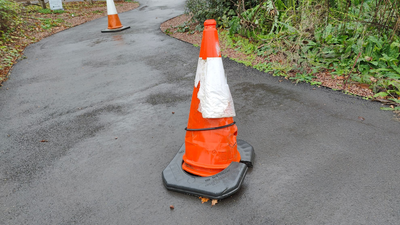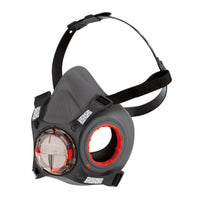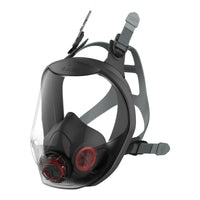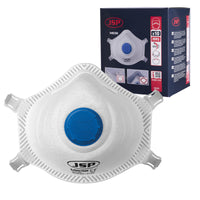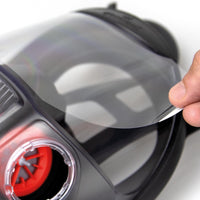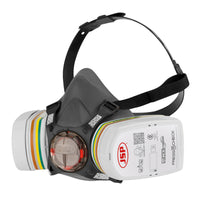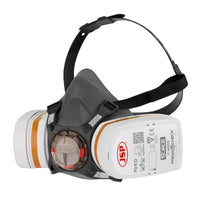The True Cost of Poor PPE Compliance
Last year the HSE estimated that more than 33.7 million days of work were lost due to workplace injuries, the equivalent of more than 15 days per person. As well as the obvious loss of productivity to the workplaces impacted, businesses across the UK also took significant financial hits off the back of these avoidable injuries.
To find out just how much British businesses spend on workplace injuries each year, we examined data from the HSE, ONS and other available Government reports and worked out that the combined expenses for statutory sick pay, recruitment for temporary staff, health insurance and compensation claims, and in some cases even court-ordered fines and legal costs, means employers pay out £21,907 on average for each workplace injury sustained.
In 2024, the total cost of workplace injuries in the UK amounted to a whopping £1,348,189,560. Injuries that – in many cases - could have easily been mitigated with the appropriate PPE.
|
Total Employer Cost Breakdown by Expense |
Total Cost |
Cost per Injury |
|
Occupational / Statutory Sick Pay payments |
£587,167,716 |
£9,541 |
|
Employers’ Liability Insurance premiums |
£523,858,571 |
£8,512 |
|
National Insurance paid on OSP/SSP |
£81,022,584 |
£1,317 |
|
Proportion of corporate private health insurance premiums attributable to work related illness/injury |
£41,331,359 |
£672 |
|
Recruitment and induction costs for temporary/permanent replacement staff |
£32,146,612 |
£522 |
|
Work reorganisation |
£27,882,266 |
£453 |
|
HSE / Local Authority investigation / prosecution - internal costs + legal costs |
£26,242,133 |
£426 |
|
Fines paid |
£18,369,493 |
£298 |
|
Administration of SSP/OSP, insurance and compensation claims |
£10,168,826 |
£165 |
|
TOTAL EMPLOYER EXPENSE |
£1,348,189,560 |
£21,907 |

Most Common PPE-Related Accidents
While slips and trips, falls from height without appropriate fall protection equipment, and injuries caused from the handling of heavy goods are amongst the most common workplace injuries recorded, we also found that exposure to dangerous and harmful substances without suitable respiratory protection is another consistent and often under-managed risk.
The most recent ONS data shows that 7.3% of workplace illness in 2024 were due to respiratory conditions, while the HSE reported that there were more than 600 injuries related to exposure to dangerous workplace conditions in 2023, costing businesses more than £13m in fees and fines.
|
Common Accident Types |
Total No. of Injuries |
Total Employer Cost |
|
Slips, trips or falls on same level |
8,085 |
£176,923,584 |
|
Injured while handling, lifting or carrying |
5,992 |
£131,122,587 |
|
Falls from a height |
2,318 |
£50,724,659 |
|
Exposure to, or contact with, a harmful substance |
632 |
£13,830,019 |
|
Exposure to fire |
129 |
£2,822,899 |
In the UK, employees that work with any type of dusts or gasses are required to wear respiratory protection equipment (RPE) to ensure that sickness caused by airborne hazards are limited as much as possible.
Properly fitted and specified RPE can offer protection against deadly substances such as asbestos dust as well as lesser-known hazardous substances such as cement, porcelain and silica dust.
PPE Non-Compliance Fines and Enforcement
In the UK it is the employer's responsibility to ensure that adequate RPE equipment is not only issued to all eligible employees, but, just as importantly, appropriately used and enforced.
British courts and HSE inspectors are increasingly putting respiratory risks under a brighter spotlight, and enforcement is slowly tightening across the UK with businesses regularly fined for failing to control airborne hazards or provide effective PPE. Recent cases include:
- £60,000 fine: popular kitchen worktop manufacturer was fined for persistent failure to control or protect workers against hazardous artificial stone dust
- £52,000 fine: a clinical diagnostics company that operates a high-containment laboratory was fined for carrying out work with high hazard infectious organisms
- £40,000 fine: a wood supplier workshop was “caked in dust” when HSE inspected, resulting in a fine for failing to protect workers against hazardous dust
- £40,000 fine: a conservatory manufacturer and installation company has been fined after an employee fell through the roof of a first-floor orangery home extension
- £5,360 fine: a construction company has been fined after workers were put at risk of exposure to asbestos

Occupational Exposure and PPE
More and more research suggests that occupational exposure to certain hazardous substances in the workplace can also cause incurable COPD, with strong evidence showing that the respiratory disease can be made worse by dusts, fumes and irritating gases. Data from HSE notes that in Great Britain:
- Around 15% of COPD may be caused or made worse by work
- 4,000 COPD deaths every year may be related to work exposures
- 40% of COPD patients are below retirement age
- A quarter of those below retirement age are unable to work at all
Employers can mitigate the risk to staff by reducing exposure to irritating substances with a robust PPE policy, according to our PPE Expert, James Crame.
“Ensuring staff are equipped with the right PPE is essential for employers, because it ensures protection physically and financially. The risks that staff face if unprotected range in severity from mild skin and eye irritation through to devastating, life-long respiratory disease, and even death in the most severe of cases.
“Research repeatedly links occupational asthma/COPD with reduced workforce participation and premature retirement, which means not only a huge loss of productivity for businesses in the short term, but a huge loss financially too.
“It’s not just the sick pay and the cost of hiring and training replacement or temporary teams, but some of the fines reported by HSE show a complete and utter lack of care for workers, which could easily have been avoided with the right PPE.
“The data is clear: respiratory risks are fuelling absence and enforcement, while investing in an airtight (pun intended) PPE programme that is adequately fit tested and up to regulation cuts employee downtime, employer legal exposure, and it pays for itself quickly.”
PPE Non-Compliance Costs by Industry
The industries with the biggest workplace injury costs are Health and Social Work (15% of total costs), Wholesale and Retail (14%), Construction (14%), Professional and Admin Services (12%) and Manufacturing (11%).
|
Industry |
Total Cost |
Employer Cost (19%) |
% of Total |
|
Health and social work |
£916,000,000 |
£174,040,000 |
15.34 |
|
Wholesale and retail |
£850,000,000 |
£161,500,000 |
14.23 |
|
Construction |
£815,000,000 |
£154,850,000 |
13.65 |
|
Professional, financial and admin services |
£721,000,000 |
£136,990,000 |
12.07 |
|
Manufacturing |
£668,000,000 |
£126,920,000 |
11.19 |
|
Education |
£526,000,000 |
£99,940,000 |
8.81 |
|
Transportation and storage |
£519,000,000 |
£98,610,000 |
8.69 |
|
Arts, entertainment and recreation |
£362,000,000 |
£68,780,000 |
6.06 |
|
Public administration / defence |
£338,000,000 |
£64,220,000 |
5.66 |
|
Accommodation and food services |
£257,000,000 |
£48,830,000 |
4.30 |
No matter the workplace, the best way for businesses to keep employees safe at work is through the implementation of high quality PPE and safety workwear items. With robust and well-fitted personal protective equipment staff can protect their lungs from dust, eyes from flying debris, and hearing from loud noises and much more.
- Author



